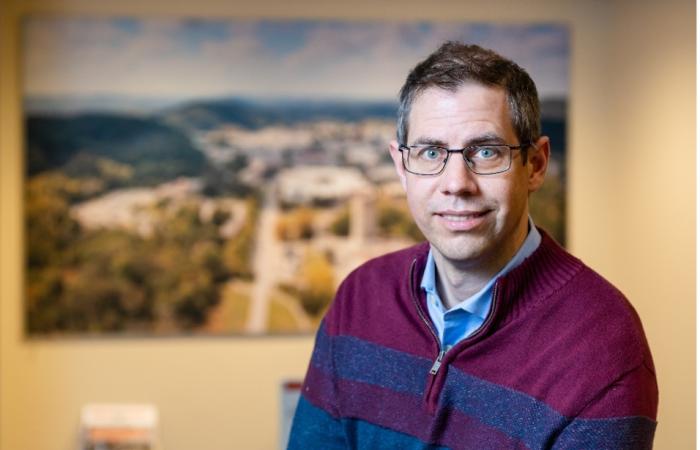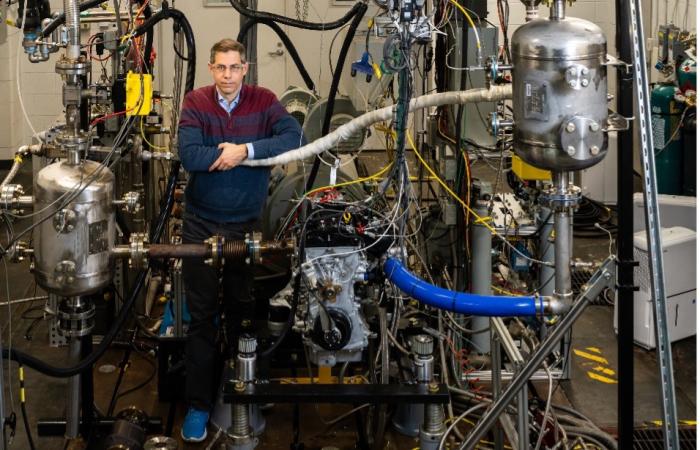-

Jim Szybist, Propulsion Science section head at ORNL, is applying his years of alternative fuel combustion and thermodynamics research to the challenge of cleaning up the hard-to-decarbonize, heavy-duty mobility sector. Credit: Carlos Jones/ORNL, U.S. Dept. of Energy.
-

Jim Szybist, Propulsion Science section head at ORNL, is applying his years of alternative fuel combustion and thermodynamics research to the challenge of cleaning up the hard-to-decarbonize, heavy-duty mobility sector. Credit: Carlos Jones/ORNL, U.S. Dept. of Energy.
-

Jim Szybist, Propulsion Science section head at ORNL, is applying his years of alternative fuel combustion and thermodynamics research to the challenge of cleaning up the hard-to-decarbonize, heavy-duty mobility sector. Credit: Carlos Jones/ORNL, U.S. Dept. of Energy.
-

Jim Szybist, Propulsion Science section head at ORNL, is applying his years of alternative fuel combustion and thermodynamics research to the challenge of cleaning up the hard-to-decarbonize, heavy-duty mobility sector. Credit: Carlos Jones/ORNL, U.S. Dept. of Energy.
What's getting Jim Szybist fired up these days? It's the opportunity to apply his years of alternative fuel combustion and thermodynamics research to the challenge of cleaning up the hard-to-decarbonize, heavy-duty mobility sector - from airplanes to locomotives to ships and massive farm combines.
The pursuit of a cleaner environment is a through line in Szybist's academic and professional career. It was the reason he decided to pursue graduate studies in fuel science, knowing that the transportation sector is one of the largest greenhouse gas emitters in the country. It's why he came to Oak Ridge National Laboratory and its unique National Transportation Research Center, an open-access user facility backed by the U.S. Department of Energy. From his time as a post-graduate to his current position as section head for Propulsion Science, he has worked closely with national lab, industry and academic partners on some of the country's most significant advances in clean mobility.
Szybist has steadily built a knowledge base on how to wring the most efficiency out of engines and fuels in pursuit of greater fuel economy and lower emissions. With new opportunities presenting themselves for decarbonization, Szybist expects to apply the same research principles to develop and refine heavy-duty engines to run on fuels approaching net-zero carbon footprint, such as methanol, hydrogen, ammonia or bio- and waste-derived fuels.
Off-road applications are difficult to electrify due to the massive energy requirements and the weight and space constraints on trains, ships and planes. Hence, the need for large engines that can run on sustainably produced liquid or compressed gaseous fuels, such as biofuels from plant biomass, methanol or "green" hydrogen produced by using renewable electricity sources.
"We're thinking about synthetic fuels that can be produced from hydrogen and carbon dioxide, including longer chain, higher molecular weight compounds that burn cleaner," Szybist said. "We're thinking about the engineering that goes into those systems. Compressed gaseous fuels, for instance, would need to be stored on the surface of a ship rather than below. These practicalities will help drive a clean fuel choice for each application."
Pivoting to net-zero carbon fuels
When it comes to understanding the thermodynamics for an efficient combustion process that results in clean exhaust, the science fundamentals are the same whether you're looking at gasoline or advanced net-zero carbon fuels, Szybist noted.
"We have the knowledge and the background to be able to apply it to these decarbonization problems. It's simply shifting to different platforms and different applications," he said.
Highlights of his progressive research at the lab include work on high-ethanol, high-octane fuel blends, including having his research cited by the U.S. Environmental Protection Agency; "stretch-efficiency" research to explore the limits of thermodynamics in engines that expanded understanding of engine combustion; and leading a multi-laboratory team and projects in the DOE Co-Optimization of Fuels and Engines initiative co-sponsored by the Bioenergy Technologies Office and the Vehicle Technologies Office.
Co-Optima developed simultaneous innovations in fuels and engines for the best efficiency and vehicle performance while lowering emissions by leveraging the unique fuel properties offered when blending biofuels with gasoline. In fact, the merit system Szybist and other Co-Optima researchers developed that evaluates fuel properties for their efficiency potential has direct application to today's research seeking to replace gasoline with pure biofuels in large-engine applications.
Science and engineering with an eye toward environmental impact
Szybist was the youngest of five growing up, and was fascinated by science and engineering from a young age. At Pennsylvania State University, he realized that his interest in chemistry coupled with a desire for practical impact lent itself well to chemical engineering, and he earned a bachelor's degree in the field. He chose a concentration in energy and fuels that he carried through his post-graduate years at Penn State.
"My earliest inclinations were to get into a field working on energy. I wanted to make transportation more environmentally friendly. My research was initially focused on biofuels and reducing petroleum consumption and criteria pollutants from engines for cleaner air," he noted.
He was encouraged in his studies by André Boehman, a professor who taught courses in energy, fuels, combustion and the environment at Penn State at the time. It was through Boehman that Szybist heard about research opportunities at ORNL. Szybist first came to the lab in 2004 as a post-master's fellow, and then later as a postdoc. He was hired as a research staff member in 2007.
Szybist touts the research independence at ORNL as a big reason he's stayed at the lab. "You really have the ability to pursue projects on whatever you can dream up," he said. "You also have the ability to cross-cut in your work, drawing on multiple disciplines and leading-edge technologies across the lab to solve big challenges. If you look at our high-performance computing, neutron diffraction and materials work at ORNL that you can interface with, the world is our oyster."
Szybist says the advice he'd give to young scientists is some he's still learning himself: "Do good work and see through whatever it is you're doing. But also be nimble to new research opportunities and emphasis."






